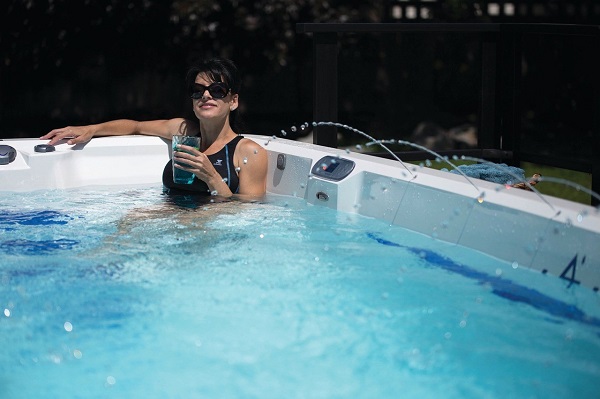Understanding hot tub chemicals and how to apply them correctly are both key components in maintaining an enjoyable bathing experience for yourself and others. Without the knowledge required to apply these products correctly, you could endanger both your hot tub and bathers.
Chlorine is an effective bacteria-killing agent that works to keep your spa clean and safe, available both as granules and tablets.
Types of Hot Tub Chemicals
Chlorine
Chlorine is an antimicrobial chemical used to kill off harmful bacteria and germs that could otherwise pose health risks in hot tub environments, but too much chlorine may irritate skin and eyes and create respiratory distress, including pneumonia-like symptoms.
If too much chlorine escapes into the atmosphere it could aggravate asthma symptoms or even pneumonia symptoms in individuals breathing it in.
There are various forms of chlorine available. Calcium hypochlorite (99% chlorine) is the most popular choice and works quickly to sanitize hot tubs.
Biguanides offer another solution that works similarly to chlorine while being easier on skin. Granules or tablets of this chemical can be added directly to the water; its effectiveness at higher pH levels decreases, therefore it is recommended to maintain lower levels of pH in water when using these chemicals.
Chlorine and bromine levels are commonly measured in parts per million units. You can check out a hot tub chemicals guide for more information. It is important to be knowledgeable about this information in order to maintain a clean and safe home hot tub.
Bromine
Bromine is the primary alternative to chlorine for sanitizing hot tub water, being available both as tablets and granules and being gentler on skin than its chlorine counterpart. Furthermore, its slow-acting mechanism and greater temperature stability makes it ideal for spas that don’t get direct sunlight exposure; its only drawback is that it releases bromamines into the water which may reduce its effectiveness over time.
Before adding chemicals to your hot tub, ensure the water is clear. Test for calcium hardness and metals such as iron to ensure optimal results. Add chemicals systematically while waiting a few minutes between additions so they can dissipate evenly.
Clarifying
Clarifiers are chemicals designed to quickly and temporarily clear, cloudy or foamy water, so having some on hand in case these problems arise is wise; however, using it as part of your regular maintenance regimen won’t solve anything deeper rooted.
Hot tubs require constant pH management to stay comfortable for use, and chemicals like pH increases or decreasers can help. Proper maintenance is vital as having too low of a pH level could make sitting uncomfortable, while too high can cause skin irritation.
Total alkalinity (TA) should also be carefully managed as low levels can make water acidic, irritating eyes and skin, while high levels can erode hot tub components. You can click the link: https://archive.epa.gov/water/ to learn more about total alkalinity. Aim for between 80 to 120 parts per million, using spa water test strips as an indicator.
Calcium hardness refers to the amount of magnesium and calcium present in your spa water. You can raise its calcium level using a hardener, adding salt water mix or using clarifiers but these solutions won’t provide long-term solutions; in such instances you must address and manage any underlying issues.
Anti-Foam
Even with proper spa maintenance, foam may still accumulate over time and need to be dispersed using defoaming chemicals in order to restore clear and beautiful waters.
When this occurs your spa must be drained, cleaned, and tested prior to adding any chemicals; using such defoaming agents may help disperse the foam so your tub water looks fresh and clear once again.
Foam may be caused by detergents left behind from soaps, lotions and oils used by bathers; or it could indicate dirty water or an algae issue in your spa. Showering before entering and regularly cleaning your filters are effective ways of minimizing excessive foaming in your spa.
Foam remover chemicals work quickly to unfoam your water, but aren’t meant to address its cause.
Preventing foaming involves draining and cleaning your spa at least every three to four months in order to eliminate dissolved solids; maintaining balanced water levels; showering before entering; using quality cleaners which have been thoroughly rinsed after each use and investing in good quality chemicals as well as high-grade filters.
Biofilm Removing
As soon as a hot tub’s water becomes polluted, bacteria and microorganisms begin to multiply, producing biofilm in its place. Hot tubs provide the ideal conditions for these organisms to flourish.
Biofilm contains toxic agents which can irritate bathers’ skin, leading to itching and rash. Prolonged exposure may even lead to serious infections called Pseudomonas aeruginosa; you can visit this site to learn more. To avoid this issue, regular use of a hot tub biofilm remover is vital.
Use shock treatments at higher-than-usual dosages to oxidize contaminants and kill bacteria, before following up with an effective sanitizer to eliminate any remaining biofilm.

